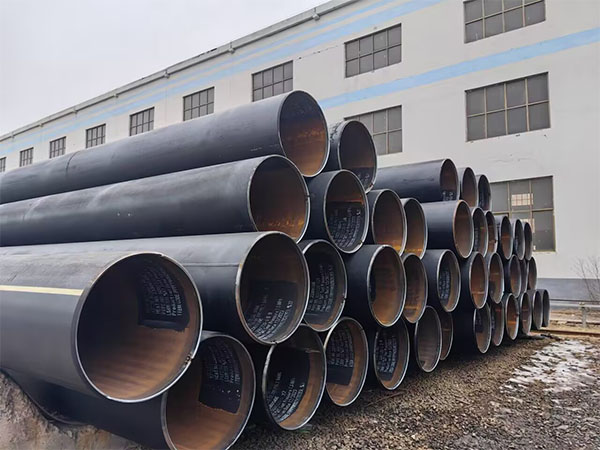LSAW steel pipe, also known as
Longitudinal submerged arc welded pipe, is made by using steel plates as the base material, processing them into shape, and then performing submerged arc welding along the longitudinal direction of the steel pipe to form large-diameter and high-strength welded steel pipes. It is widely applied in multiple fields such as oil transportation, gas transportation, water treatment, bridge construction and structural support.

The manufacturing process of LSAW pipes
The manufacturing process of LSAW ( Longitudinal submerged arc welded pipe) pipes is complex and precise, and can mainly be divided into five key stages. Every step is carefully controlled to ensure that the finished pipe has outstanding strength and reliability.
1. Raw material preparation
Uncoiling and leveling: Unroll large-sized steel coils, and use a leveling machine to remove internal stress and bending to ensure that the steel strips are flat and free of curled edges.
Finishing and trimming: The edges of the steel strip are cut and trimmed to obtain a uniform and smooth welding allowance.
2. Preforming
There are two forming methods for LSAW steel pipes, namely the UOE process and the JCOE process.
UOE process: The UOE process is a commonly used method for manufacturing large-diameter straight seam welded pipes. This process first uses a hard alloy milling machine to bevel the longitudinal edge of the steel plate. These beveled steel plates are first formed into U shapes using a U-shaped press, and then further formed into O shapes using an O-shaped press.
JCOE process: The JCOE process is another important method for forming LSAW steel pipes. This process first conducts edge pretreatment on the steel plate to ensure its suitability for the subsequent forming steps. Subsequently, the steel plate is sent into the C-type press and formed into a C shape through precise pressing actions. Immediately after, under the action of the O-shaped press, the C-shaped steel pipe is further formed into a complete circle. During this process, each step must be strictly controlled to ensure the precise geometric dimensions of the steel pipe and to guarantee that the welding area of the steel pipe is fully prepared, laying a solid foundation for the subsequent welding steps.
3. Submerged arc welding
Longitudinal welding: Granular flux is applied at the joint of the pipe body, and double-sided or single-sided multi-wire submerged arc welding is carried out. The arc stably burns under the flux layer, fusing the edges of the steel plate to form a dense weld seam.
Penetration depth and weld formation: By adjusting the current, voltage and flux flow rate, the penetration depth and weld contour are optimized to ensure no cracks and no undercutting.
4. Cold expansion and straightening
Cold expansion and straightening: By using metal rollers or hydraulic pipe expanders, the pipe blanks after welding are expanded and straightened at room temperature to release residual stress and improve dimensional accuracy and roundness.
Non-destructive testing: By combining ultrasonic, X-ray, magnetic particle or penetrant testing, it conducts rigorous inspection of welds and pipe bodies to eliminate minor defects.
5. Surface treatment and factory inspection
Anti-corrosion coating: According to application requirements, epoxy powder, 3PE/3PE and other anti-corrosion layers are applied, or inner and outer wall sandblasting, painting and other processes are carried out.
Hydraulic testing and measurement: Test the pressure-bearing capacity of pipelines in a high-pressure hydraulic press, and conduct final inspections on outer diameter, wall thickness, straightness, etc.
Bundling and packaging: Qualified products are separated by brown straps and wooden wedges and loaded, ready for factory release.
Specifications and Performance
Outer diameter: approximately 406 - 1625 mm (16 - 60+ inches).
Wall thickness: generally 6 - 60 mm, up to approximately 26 mm for X70 grade, up to approximately 24 mm for X80 grade.
Length: Usually 2 - 18 m. Some manufacturers also offer extended tubes up to 12.2 m and 12.8 m.
Mechanical properties: It features high strength, high toughness, high plasticity and strong impact resistance
; The internal stress is low and the dimensional accuracy is high after cold expansion.
Main features
Large diameter, thick wall, high pressure resistance: Suitable for high-pressure long-distance pipelines.
Excellent weld quality: Double-sided submerged arc welding ensures density and uniformity.
High dimensional accuracy and low internal stress: conducive to construction and on-site re-welding.
Easy for non-destructive testing: Welds can be comprehensively inspected during production and use.
High economic efficiency: Suitable for batch and large-scale production.
The application of Longitudinal submerged arc welded pipe
LSAW pipes have extensive applications in various industries. The main uses include:
Transportation of oil and gas
Natural gas distribution network
Central heating system
Water supply infrastructure
Sewage treatment facilities
Low-pressure fluid conveying system
